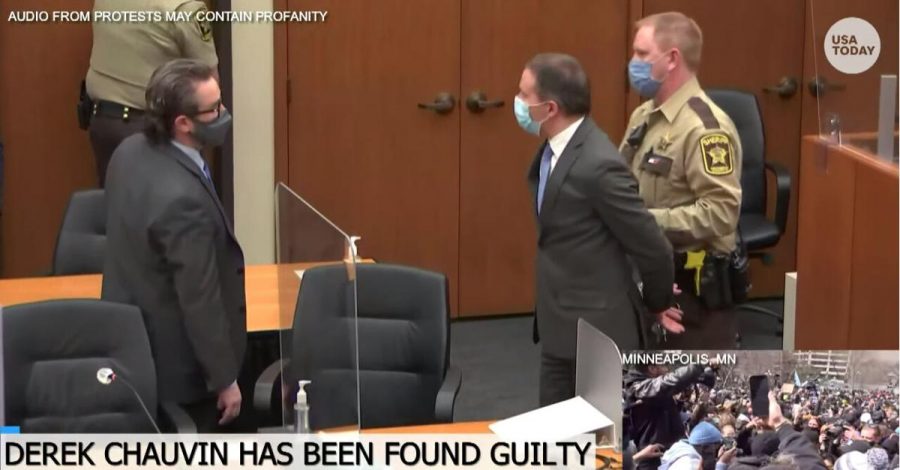Derek Chauvin’s legacy of shame
Derek Chauvin is led out of the courtroom in handcuffs after a guilty verdict is read during the trial of Derek Chauvin of the death of George Floyd at the courthouse in Minneapolis on April 20, 2021. Mandatory Credit: Court TV/Handout via USA TODAY NETWORK
Published April 20, 2021
On Tuesday afternoon, not even 24 hours after starting its deliberations, a multi-racial Minneapolis jury of seven women and five men found former Minneapolis police officer Derek Chauvin guilty of second-degree murder, third-degree murder and second-degree manslaughter in connection with the death 11 months ago of George Floyd, a 46-year-old resident of the Twin Cities.
Chauvin’s legacy is certain: He was a white cop who responded to a report of a nonviolent minor crime at a small neighborhood grocery and within about 20 minutes of arriving at the scene had suffocated to death a Black man who used a counterfeit $20 bill to buy cigarettes.
If Chauvin had been found not guilty, his legacy would be the same — with the added footnote that not only did he do this but he also got away with it. Statistically, it would not have been unusual. Law enforcement personnel in the U.S. are rarely charged for actions taken during on-duty interactions and are even more rarely convicted.
In this case, by the time Chauvin got to the store, Cup Foods, two cops who had arrived before him had taken Floyd into custody and handcuffed him behind his back.
They had put Floyd into the back seat of their squad car, but Floyd cited claustrophobia and became fearful and agitated. As various videos made by businesses and bystanders recorded, Chauvin intervened at that point, pulled Floyd out of the police car and placed him face down in the street next to the vehicle. Chauvin then pushed his right knee into Floyd’s back while three other officers used their arms and knees to press Floyd’s torso and legs against the pavement, severely compromising Floyd’s ability to draw breath.
Simultaneously, Chauvin used his left knee to grind into the right side of Floyd’s neck, substantially reducing the flow of blood to Floyd’s brain. Chauvin kept this up for nine and a half minutes.
For the first four or so of those minutes, Floyd moaned desperately in pain, begged Chauvin to let him breathe and tried in vain to squirm into a position that would allow his body to take in enough oxygen to survive. In gasps, he cried out to his dead mother.

Chauvin and the other officers ignored Floyd’s pleas, except for the couple of times that the kneeling Chauvin responded to the cries by raising his own body up on the toes of his shoes and used the additional leverage to press down even more forcefully on Floyd’s neck and back.
As the minutes ticked by, Floyd’s outcries gradually faded into silence, his body movements ceased and he became unresponsive. But Chauvin kept his knee in Floyd’s neck for several minutes more. Neither he nor his fellow officers tried to revive Floyd.
Derek Smith, an EMS paramedic who arrived a few minutes later with an ambulance crew, testified at Chauvin’s trial that he found Floyd without a pulse and with dilated pupils. Treatment Floyd got in the ambulance on the way to a hospital was unable to restore his pulse, Smith said.
Watch the video.
If you’ve seen it before, watch it again. You know the video I’m talking about, the one that shows much of what I’ve described above. A courageous young woman named Darnella Frazier, then 17 years old, recorded it on her phone. It’s 10 minutes of George Floyd — his face, neck and body compressed against a grimy Minneapolis street — slowly being killed by Derek Chauvin.
Frazier and her 9-year-old cousin had walked to Cup Foods to buy some snacks and just happened upon Chauvin and his fellow officers dealing with Floyd in the street in front of the grocery. Concerned for her cousin’s well-being, Frazier made sure the girl went inside.
In her testimony at Chauvin’s trial, Frazier said she didn’t want her cousin to have to see what Frazier had noticed as they approached the store: “A man terrified and scared, begging for his life,” she said.
And why did Frazier then walk the 30 feet or so back to where Chauvin and the other officers were crushing Floyd against the pavement? “It wasn’t right,” she testified. “He was suffering. He was in pain.”
She began recording.
Cops caught on video using force, sometimes excessive force, in pursuing, subduing and arresting people are not a rare phenomenon. Tragically, such footage has become all too commonplace, thanks to the widespread ownership of cell phones with recording capability, the universal distribution of clips through the Internet and social media and the frequency of violent incidents. Some 1,000 people are shot and killed in the U.S. each year by on-duty law enforcement officers, according to an independent database created by the Washington Post. That’s an average of about three per day.
But Frazier’s video is different, both in content and in impact.
It is utterly lacking, for example, in the kind of action moments that invariably spread and build online attention.
There is no high-speed vehicle chase in Frazier’s video, for example, and no breathless foot chase down a dark alley, either. Nobody’s screaming, “Show me your hands!” There are no punches thrown, no shots fired, no panicky radio calls for help. And Floyd, handcuffed and immobilized, poses no threat to anyone.
Yet Frazier’s video of his absolutely needless death has shocked the conscience of decent people around the world, including decent members of law enforcement. No matter how many times I watch it, it evokes in me a profoundly disturbing combination of emotions: anger, shock, bewilderment, fear, hopelessness and aching sorrow. The idea that, at some point, Floyd knew he was going to die in the street as his life was squeezed out of him is almost too much to bear.
That Floyd’s killer showed not the slightest trace of human decency as he did these horrific acts — whatever a jury had determined about their legality — ensures the eternal shamefulness of his legacy, assuming history makes a record of his name at all.

















